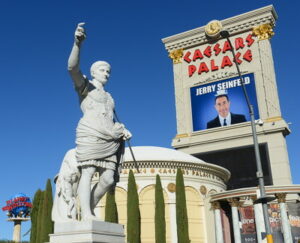 When we look back in history at sports, many of us consider Ancient Greece as a starting point. After all, the Greeks were hosting the ancient Olympic Games back in 776 BC. They existed as a series of athletic competitions among representatives of city-states. Held in honour of Zeus, the Greeks gave these Olympics a mythological origin.
When we look back in history at sports, many of us consider Ancient Greece as a starting point. After all, the Greeks were hosting the ancient Olympic Games back in 776 BC. They existed as a series of athletic competitions among representatives of city-states. Held in honour of Zeus, the Greeks gave these Olympics a mythological origin.
As is the case with today’s Olympics, the games took place every four years. These games carried on even when Greece came under Roman rule in the 2nd century BC. The last recorded celebration was in AD 393, under emperor Theodosius I. Yet historical evidence also suggests they continued after this time.
A fire at the temple of the Olympian Zeus likely brought an end to the games under Theodosius II. But despite the lengthy running of these Olympics, there is evidence that the Romans did more. While they may not have created sports or the love of it, they may be responsible for something else. Our love of gambling on sporting events could have its origins in Ancient Rome.
The ancient Romans spent a lot of their time not only watching games and races. They also placed bets on the events, and they wagered large quantities.
It was even the case that Romans could not play simple board games without placing a bet. Sometimes, they would wager large amounts of money. And because so many board games existed then, there were ample gambling opportunities. Here, we will take a look at the influence the Romans had on today’s sports and gambling spheres.
The Greeks Introduced Sports, the Romans Saw Them as Bloody Entertainment
![]() In Ancient Rome, sport was a popular and widespread activity. It provided thrills and entertainment to all who could afford to spectate. Yet the Roman idea of sport was very different to that thought up in Greece. With the latter offering competition for Greek men, the Roman’s had a different view. Their sporting events brought on bloody duels and outcomes resulting in death.
In Ancient Rome, sport was a popular and widespread activity. It provided thrills and entertainment to all who could afford to spectate. Yet the Roman idea of sport was very different to that thought up in Greece. With the latter offering competition for Greek men, the Roman’s had a different view. Their sporting events brought on bloody duels and outcomes resulting in death.
And when the Romans took over Greece, the sanctity of the country’s sports disappeared. Instead, the Romans introduced the blood-thirsty thrills of their own mindset. Sports in Rome included basic options, but the violent ones achieved greater popularity. This saw boxing and wrestling go on to become prime sports in Ancient Rome.
Pankration – a Greek sport mixing boxing with wrestling – became much loved. Before long, the love of violent sports led to the formation of gladiators. Many large amphitheatres played host to events around various European locations.
At all events that took place around Ancient Rome, gambling was also present. This was a way for Romans to enjoy their pastime and relax. Drinking and gambling often went hand-in-hand and could also lead them to an early grave at times. Yet this didn’t stop the Romans from continuing to gamble. It remained popular throughout the empire’s presence.
The Romans also loved games of chance in general, though. They had a particular fondness for dice games, with pairs of them thrown from a cup. A wall painting from Pompeii depicts two men sitting at a wooden table, playing dice. Scratched into the walls are various inscriptions too, with one of them stating:
“At Nuceria, I won 8552 denarii by gaming — fair play!”
Nuceria Alfaterna was one of the largest cities of ancient Campania. It served as the capital of the Lega nucerina, which included Pompeii and other cities.
Dice Games Prove Popular for Bettors
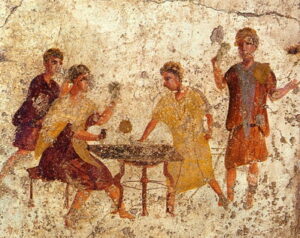
Dice games are something that were popular throughout Ancient Rome. Known as Tesserae, it served as a game of chance. Players would wager money and various other material possessions on the outcome. The basic idea was to bet on the outcome of the die, which would then roll from the cup. The player who predicted the correct result won. Sort of like a primitive version of today’s craps.
Most of the time, people played Tesserae in taverns, brothels and gambling houses. History says that brutal Roman emperor Commodus turned the Imperial Palace into a casino. He did so to be able to regenerate money he had whittled away from the treasury.
Yet even Caligula before him had done the same thing. He was a big cheater and a terrible loser, according to historians. So bad that if he did suffer a big loss, he would order guards to execute rich citizens. That way, he could continue gambling with their estates!
When Commodus arranged for the palace to become a gambling house, it didn’t end well. A nationwide gambling problem broke out in Ancient Rome in the following years. It wasn’t until Augustus came to power that things would change.
He restricted gambling to a single week of the year, entitled Saturnalia. Slaves and masters could both gamble as much as they liked during that time. Augustus himself, of course, allowed himself to gamble outside of that timeframe.
Chariot Racing Provided Opportunities for Sports Betting
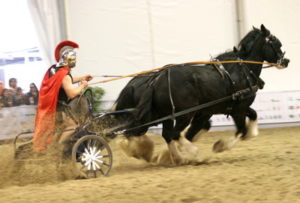 People may believe that horse racing has only been around for a couple of centuries. But actually, its origins date back a lot further than that. Chariot racing was something that occurred in Ancient Rome. It was brutal. It was dangerous and it was very entertaining. Thus, it appealed to the Romans and their bloodthirsty nature. It also offered them a great opportunity for placing bets.
People may believe that horse racing has only been around for a couple of centuries. But actually, its origins date back a lot further than that. Chariot racing was something that occurred in Ancient Rome. It was brutal. It was dangerous and it was very entertaining. Thus, it appealed to the Romans and their bloodthirsty nature. It also offered them a great opportunity for placing bets.
Only the rich and powerful of Ancient Rome could gamble on chariot races. It was more of a gentleman’s bet between two people that took place.
Further to this, the emperor was always present at chariot racing events. The imperial box, known as the pulvinar, had a connection to the imperial castle. Chariot racing became the height of entertainment for many years in the Roman era. It stood alongside gladiator battles and events at the Colosseum as a big favourite.
The home of chariot racing in Ancient Rome was the Circus Maximus. This venue could hold up to 150,000 spectators, measuring 621 metres in length. It also became the model for circuses throughout the Roman Empire. Back then, people were loyal to their favourite chariot racing teams.
Deep factions formed between rival teams and supporters. It was common for the teams to have powerful and wealthy financial backing. Sort of like many of today’s top Premier League football clubs.
Think of it as an early form of sponsorship programs! The amount of money behind a chariot racing team would often denote their success. After all, being able to afford better drivers and horses ensured they would win more often.
Gladiator Fights Rule the Roman World
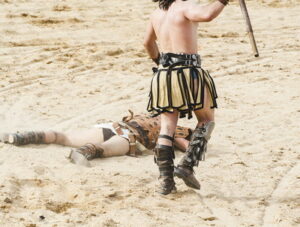 Chariot racing and other events within the Colosseum may be top-quality entertainment. But gladiator fights were more likely to be the cream of the crop. Battles usually included two men battling it out, but there were also battle royales.
Chariot racing and other events within the Colosseum may be top-quality entertainment. But gladiator fights were more likely to be the cream of the crop. Battles usually included two men battling it out, but there were also battle royales.
This saw several men participating in fights to the death, with only one coming out as winner and as with all Roman sports, gladiator fights saw betting take place. A tricky affair it was, though. One gladiator tended to be better equipped for the fight, and often had better skills. The underdog rarely came out on top and because of this, there weren’t many gentleman’s wagers placed.
Any time such a wager did occur, it often resulted in big fights and not only between the gladiators, either. The bettors involved would try to cheat one another out of their winnings. Often times, one of the people would end up knocked out or dead as a result. Ancient Rome was not a place to get into arguments!
Tabula Performs Well with Ancient Romans
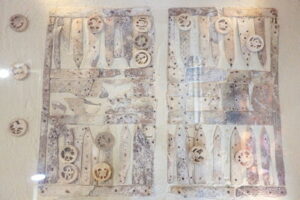
The game that we know today as backgammon originates from Ancient Rome. In that time, it went by the name of Tabula. Players would roll dice and attempt to remove markets off the board as quick as they could.
Emperor Claudius was very fond of playing Tabula. History suggests that he would engage in rounds for hours upon end. He wrote a book on the history of the game, with records stating that he worked on it for many years. So popular was this game that it was equal to today’s fads of Candy Crush or Angry Birds.
Another board game that the Romans loved was “The Game of Brigands”. This was a strategy game, utilising different-coloured glass pieces. The player who captured the most of these pieces became the winner at the end. Looking at the game today (which in Latin was called Ludus latrunculorum), it resembles draughts.
This came about as a variation of an earlier Greek game called pente grammai. Later versions of the game incorporate black and white pieces. This is more in-line with the draughts setup of today. The primary difference is that The Game of Brigands centred on military strategy.
Such games would often travel to different military outposts via soldiers. If they had enough time on their hands, they would set about playing against other soldiers. As a result of this transportation, excavators have unearthed game boards in many places. This includes not only across Italy, but in England and North Africa, too.
Starting Out Young

When considering gambling today, we usually think of adults engaging in it. Although, in saying that, an increasing number of children have also had links to it in recent times. Yet that is something that wasn’t uncommon in Ancient Rome. Youths would often find themselves initiated into gaming and gambling. It would usually occur through the game “Nuts”.
This game entailed children trying to throw nuts into a jar or a triangle traced on the floor. The triangle would have different divisions on it, featuring different values. An alternate version of the game saw a nut stacked on top of three others. A fifth nut was then thrown at them from a distance. The idea was to try and topple the castle with the fifth nut.
Another children’s game was Rota. It had a similar setup to it as today’s tic-tac-toe. Utilising a board with a wheel drawn on it, each player had three pieces. The one who lined up all three pieces in a row on the board was the winner of the round. Meanwhile, an Ancient Roman version of “heads or tails” also existed. It went by the name of “Heads and Ships”. The copper coins in Ancient Rome had ships on the reverse side, hence the title of the game.
An Obvious Influence
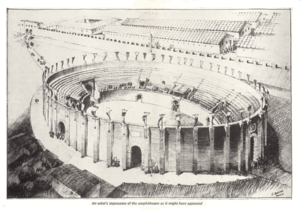
Could we say that Ancient Rome created our love for sports and betting today? Well, the Romans definitely had an influence on it, without a doubt.
The Greeks came before the Romans with sport, but it was the latter who introduced gambling and even with restrictions placed on it at several times, it stuck around. Throughout the proceeding centuries, people across Europe and the world have adored betting. Whether that is on sports, board games, casino games or whatever, it exists.
If the Roman’s didn’t gamble in such a heavy way, it may be the case that it wouldn’t have come to be today. The love of sports can definitely trace itself back to Ancient Greece and that is something that has held a place in people’s hearts ever since but the Romans took it into various other territories. Of course, sports and betting have both evolved even more since those primitive days. But the foundations of it remain the same for the most part.
Just like the Romans, many people today enjoy partaking in gambling. Without a doubt, there are more things to wager on today than back then. The difference is that games and sports today aren’t bloodthirsty spectacles. Events like wrestling and boxing can sometimes reach that point. Although, there is no intent for competitors to die by the end of an event.
The influence of the Romans remains strong, regardless. Who knows – it may be the case that people will be gambling for centuries to come. Could we also leave our own mark on the industry?
